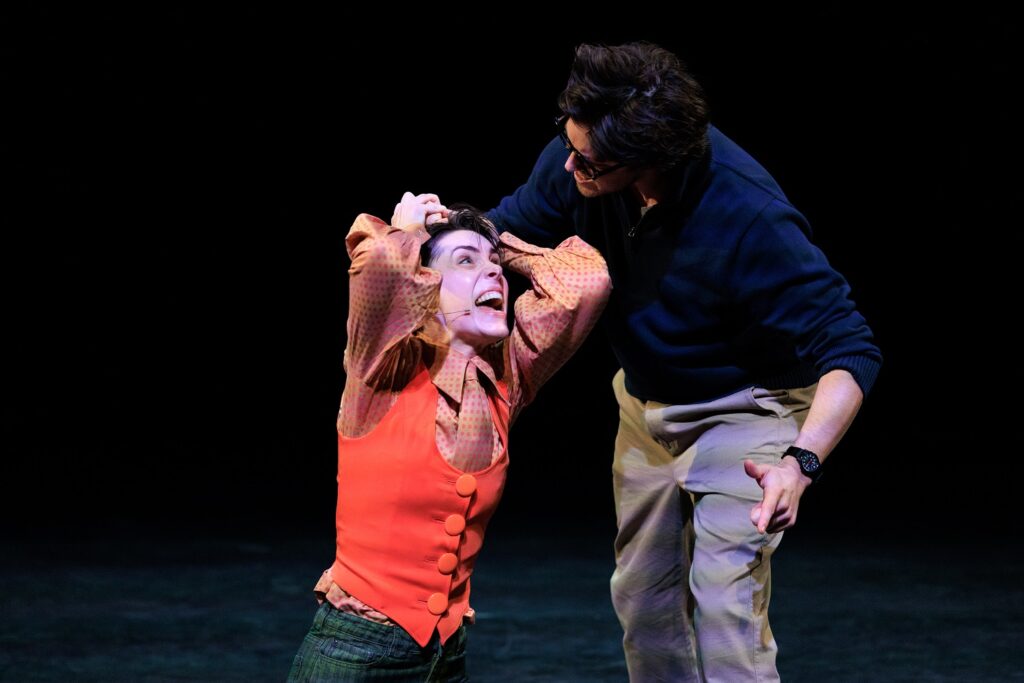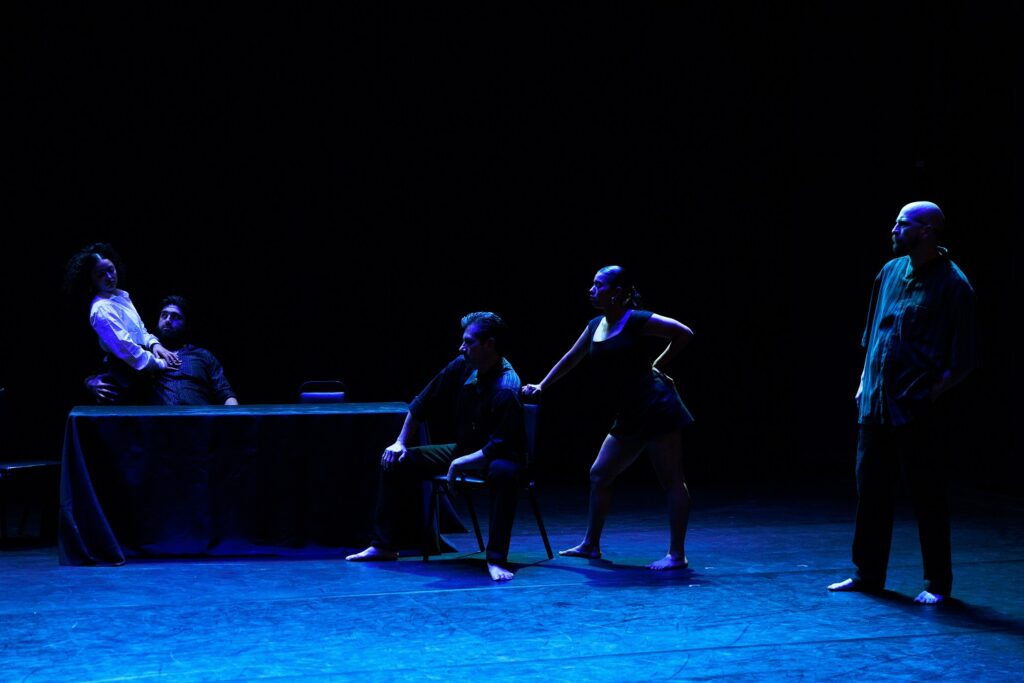A sold-out house at REDCAT for the Friday night showing, on week two of its 21st annual New Original Works Festival, feels like stepping into the before times. It’s busy, it’s warm, the Los Angeles performing arts community is showing out.
I think it was the lightness of this welcoming atmosphere that made this week’s program — which bristled with heavy subject matter — almost jarring to experience once I sat down. But like Ajani Brannum said as they opened the show with their work CONGRESS, “something is supposed to shift by the end of this.”
Brannum’s CONGRESS was deceivingly structural, an open format where five contributing artists conducted research in different mediums: Cory Jones via storytelling and movement, Héctor Alvarez via film, Juniper Jones via sound score, Azwaw Medkour via timekeeping and text, and Brannum holding the space via text, commentary, and movement.
Program notes describe the collective as “representatives of both themselves and their historical inheritances….conjur[ing] and confront[ing] patriarchy’s ghosts.” Brannum asked the audience to define patriarchy, and to consider whether our neighbors would answer the same.
I felt deep discomfort in viewing patriarchy and my role in it through this lens, a sign that Brannum’s call was working its way through my system effectively. I could observe (or participate in) CONGRESS over and over again — the work was both simultaneously straightforward (Brannum introduces each new element, walks the audience through the work as it passes) and overwhelmingly rich. Brannum’s thoughtful movements, dispersed among poetry, were captivating, some imbued heavily with dramatic meaning and some simply exploring with curiosity.
Brannum was extremely successful in crafting what the program notes describe as an “investigation into what performers do on behalf of those who witness them…draw[ing] the audience in to confront bodily forms of oppression and remake the roles that hold together a suffering society.” Each artist’s accounts of generational understanding, moving forward alongside Medkour’s active timekeeping, painted a canvas on which we saw our biases revealed to us. I left not necessarily with more clarity than I had when I entered the theater, but carrying more information, something most definitely shifted underneath.

Week Two of REDCAT NOW Festival 2024 – Sophia Cleary, Joshua Kilcoyne in “Read The Room” by Sophia Cleary – Photo by Angel Origgi.
Next came Sophia Cleary’s Read the Room, in which Cleary (the work’s writer, performer, and director) played an actor, and actual actor Joshua Kilcoyne played opposite as her director. Cleary read further and further into her script, constantly interrupted by Kilcoyne’s toxic jabs. As performer, she played expertly to the audience. Discreet responses to the director but for the audience made her easy to root for and characterized movement references deployed just at the right time won viewers over (thanks to movement consulting by Emily Barasch). One audience member blurted out, “fire him!”

Week Two of REDCAT NOW Festival 2024 – Sophia Cleary, Joshua Kilcoyne in “Read The Room” by Sophia Cleary – Photo by Angel Origgi.
Both performers reacted effortlessly to the heckling, a heightening of the stakes. Once Kilcoyne as director had crossed several boundaries (though none of them particularly surprising for a director, just still difficult to watch) he turned to the audience to remind us: “I’m just an actor. She wrote this.” The question — who (or what) wields control here — was further outlined by the performers’ challenge to the audience to get up and leave, if we wanted to.

Week Two of REDCAT NOW Festival 2024 – Sophia Cleary in Her “Read The Room” – Photo by Angel Origgi.
Cleary’s refrain, “Isn’t live performance so amazing?” echoed above it all. The control shifted with each interaction, in yet another work challenging the audience’s role/responsibility during live performance. It was disorienting, tense, even violent. Yet no audience members got up to leave.

Week Two of REDCAT NOW Festival 2024 – Sophia Cleary, Joshua Kilcoyne in “Read The Room” by Sophia Cleary – Photo by Angel Origgi.
Having seen and enjoyed a version of Read the Room at Human Resources earlier this year, I found it satisfying to see the work effectively edited (directing by Cleary, assistant directing by Amrita Dhaliwal) in favor of supporting its thesis, rendering the denouement much stronger and clearer. Costumes by Greta Langenberg added to the staging but didn’t distract.
The Tijuana Dance Company closed the evening with Salón México, “an examination of the borderland staged in a dance hall.” Director and choreographer Dulce Escobedo carved Tijuana nightlife out of the REDCAT stage, the ensemble bringing us instantly to the salón with their first movements.

Week Two REDCAT NOW Festival 2024 – Tijuana Dance Company in “Salón México” – Photo by Angel Origgi.
As the club scene unfolded, Escobedo’s movement proved consistently multilingual, eloquent and also explosive. The performers, Cristóbal Dearie, Marianna Escobedo, Elie Korio, Sara Ramirez, Pablo Francisco Ruvalcaba, Tristan Samson, Linda Paola Varela, and Amanda Zenaida, were committed in all efforts.
Part of the company’s stated mission is to use a unique common movement language to embrace dancers and non-dancers, which Escobedo and the performers did well. They established the setting and each held the energy with fervor; so much so that I was invested in their relationships, and wanted more time with specific interpersonal dynamics before the conflict arose. (I also could’ve missed context because of my absolute lack of proficiency in Spanish.) The chaos of Salón Mexico felt accurate — I just hoped for more moments of focus and simplicity to cut through.

Week Two REDCAT NOW Festival 2024 – Tijuana Dance Company in “Salón México” – Photo by Angel Origgi.
Dancers moved in short, bursting passes across the floor, which made the arrival of full-cast unison sections deeply satisfying. The interactions turned darker as the night progressed. Partnered depictions of domestic and/or intimate partner violence were haunting. Once the club cleared out for the night, a film followed the dancers the rest of the way home, illustrating and then spelling out the tragic statistics on the death toll from drug activity on the Tijuana border, particularly as they affect women.
As expected, I am pushed out of my comfort zone at REDCAT in the best way. Chu-Hsuan Chang’s lighting always makes me fall deeper into the world the artist is creating, and I am invested in the future of all of these new original works.

Week Two REDCAT NOW Festival 2024 – Tijuana Dance Company in “Salón México” – Photo by Angel Origgi.
But the heaviness of these three pieces in a row sits with me still, a few days later. To be clear, I don’t think their heaviness affects their validity. Each artist confronted something difficult and made effective work of it. Perhaps a more specific content warning is all I needed. But I do think this evening at REDCAT posed an interesting question about whose burden it is to bear the heaviness, or about how to define the social contract we agree to as art audience members and performers.
Week Three of REDCAT’s NOW Festival 2024 continues November 21-23 featuring works by choreographers Bret Easterling, Mallory Fabian, and Kensaku Shinohara. For more information and to purchase tickets, please visit their website.
Written by Celine Kiner for LA Dance Chronicle.
Featured image: Week Two REDCAT NOW Festival 2024 – Tijuana Dance Company in Salón México – Photo by Angel Origgi.










